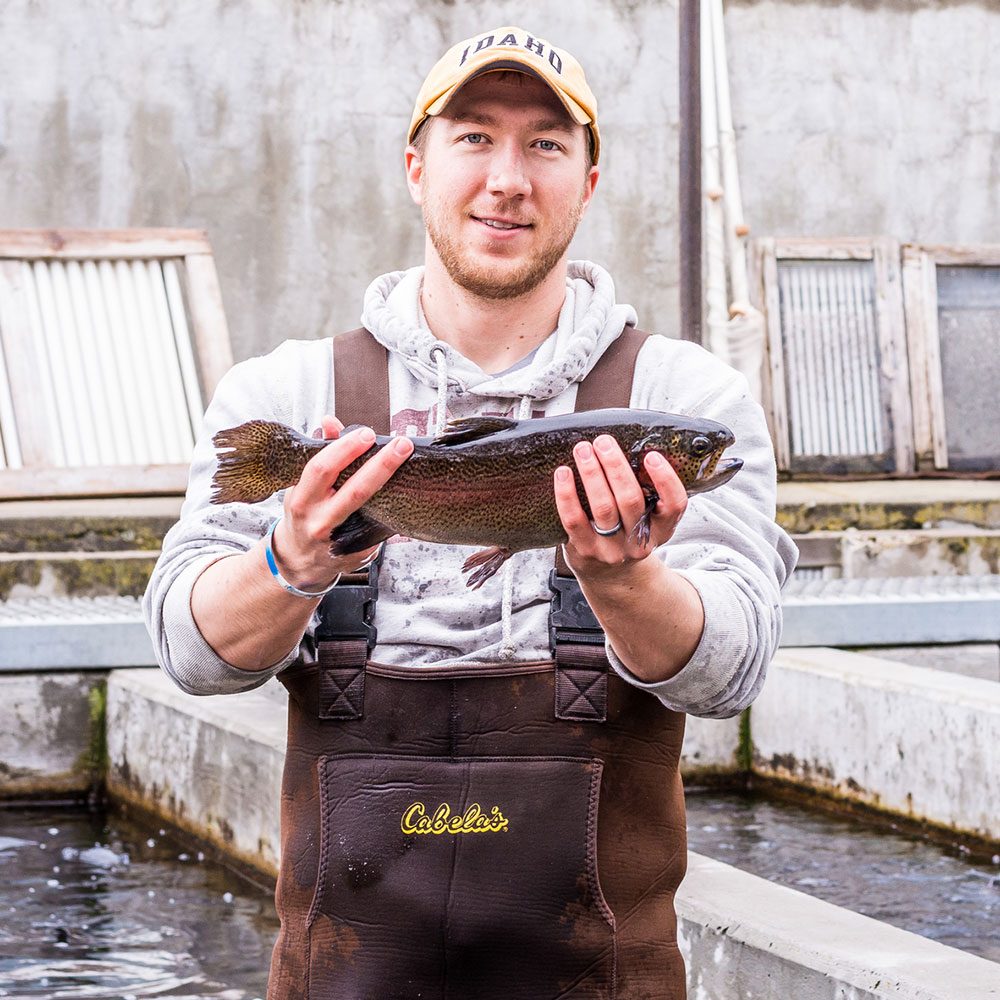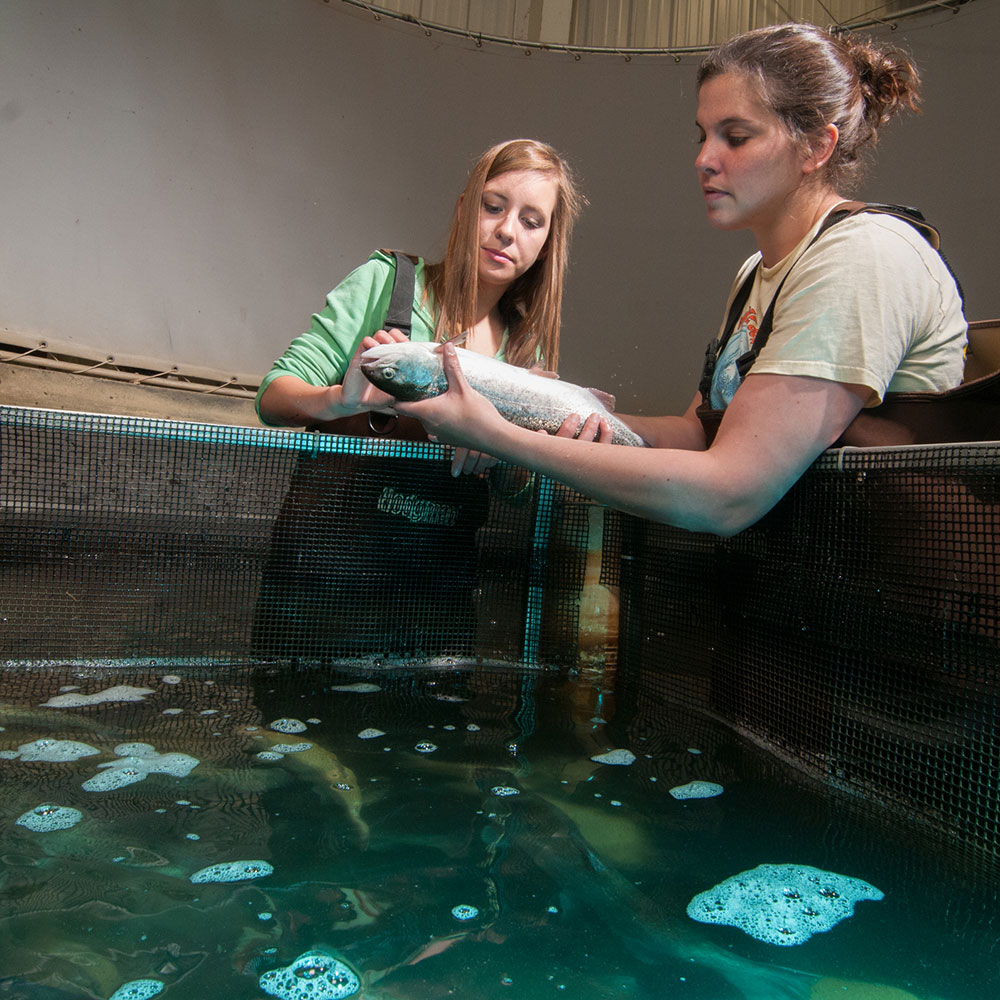Growing Fish for the Future
Helping Fish Feed the World
Overview of the University of Idaho's Hagerman Fish Culture Experiment Station.
Farmed fish feed millions of people around the world every day. More than 70 percent of the farm-raised trout that end up on American tables comes from one state: Idaho.
At the University of Idaho’s Aquaculture Research Institute (ARI), scientists are working to ensure those fish are grown economically, efficiently and in a healthy way.
The Diet of the Future
The number of wild-caught fish has declined in recent years, but as the human population increases, so does demand for fish in the diet, says Ronald Hardy, ARI director and a professor in the UI College of Agricultural and Life Sciences. Hardy is based at ARI’s Fish Culture Experiment Station in Hagerman, Idaho.
“Where are we going to get the fish to feed the growing population?” Hardy says. “Fish farming is the only source, and to grow them in aquaculture production, we have to feed them.
Feed made from processed fish, known as fishmeal, has traditionally been the primary source of protein in farmed-fish diets. But fishmeal is a finite resource, and the global aquaculture industry already consumes nearly 75 percent of annual fishmeal production.
In a long-term partnership with the USDA’s Agriculture Research Service and Idaho’s aquaculture industry, ARI researchers have developed a strain of rainbow trout that can grow fast and healthy not on fishmeal, but on an all-plant, soy-based diet.
“It’s the diet of the future,” Hardy says.
The project has taken 14 years of precise selective breeding over seven generations.
“In the fourth generation we produced some families that actually did as well on the plant-based diet as they did on the fishmeal control diet,” Hardy says. “By the sixth and seventh generation, the selected trout actually grow faster on the plant-meal diet than on the fishmeal diet.
What’s more, the fish also grow to harvest size twice as fast as fishmeal-fed trout, and studies show they are also more disease-resistant than non-selected trout strains.
These special trout are already benefiting Idaho’s industry, Hardy says. For example, at Buhl-based Clear Springs Foods Inc. – the world’s largest trout farm, which produces about half of the farm-raised trout in the nation – 10 percent of the company’s broodstock is from trout strains bred by ARI and the Agriculture Research Service.
Scott LaPatra, director of research and development for Clear Springs, says ARI’s work is excellent and has been valuable in addressing the industry’s needs. The company has supported ARI work with additional expertise and facilities for field trials.
The ability to feed fish a modified diet provides companies like Clear Springs with potential increased efficiencies, such as faster growth, faster time to market, less waste and better health, La Patra says.
“Feed is our No. 1 cost, so anything we can do to cost-effectively tweak that diet, those are the projects we get excited about,” he says. “We’re a major resource user, so anything we can do to further reduce environmental impacts is a very positive thing to, and that comes with better feed utilization, less waste.”

Preventing Damaging Disease
At ARI’s Moscow branch, another project set to benefit Idaho’s aquaculture industry is a coldwater disease vaccine developed by Ken Cain, associate director of ARI and a professor in the UI College of Natural Resources.
In winter 2014, Cain finalized a licensing agreement with a large pharmaceutical company that produces fish vaccines and is moving forward working toward the final stages of vaccine optimization for USDA approval and commercial sale. Cain received a $105,000 grant from the Idaho Department of Commerce's Idaho Global Entrepreneurial Mission in October 2015 to test the commercial version of the vaccine to make sure it's as effective as the lab-made version.
Coldwater disease is a bacterial infection that afflicts farmed and wild fish, primarily trout and salmon, worldwide. An outbreak can cause a hatchery to lose 30 percent or more of the fish it hatches.
“It’s a big problem in the trout industry in the U.S., and it’s also a major problem in other hatcheries,” Cain says. “They lose more fish to that disease than any other disease.”
Cain began investigating the potential for a vaccine when he came to UI 15 years ago. By 2008, he had a vaccine that could prevent the disease, but needed to develop an efficient way of inoculating baby fish that only weigh a few grams.
“To vaccinate a fish, especially in Idaho where they grow millions, you can’t just inject every fish,” Cain explains. “It would be too costly and too much work.”
Cain refined a method for vaccinating fish using immersion, and patented his vaccine in 2010.
His research has been supported by funding through USDA and collaboration with Northwest aquaculture companies, such as Clear Springs Foods and SeaPac, as well as Idaho state hatcheries, which have helped him conduct field trials.
Cain says it will take about one to two years to complete laboratory and field trials and receive USDA approval for the final vaccine.
“There’s the potential to sell millions and millions of vaccine doses in the U.S., and it could go global as well,” he says.

Wide-ranging Research
A wide range of other current ARI projects also are aimed at supporting the aquaculture industry.
Cain has patented a probiotic product for fish, is studying whether his vaccine can cross-protect against infections similar to coldwater disease and is also working with the Kootenai Tribe and others to develop techniques for raising fish such as burbot to recover dwindling populations in the wild.
Hardy is continuing his research into sustainable feeds, including working with ARI partners to study the physiology and genetic variables that make the selected trout strain grow well on plant-based feeds, as well as studying how microbes in fish intestines affect the way they respond to the diet. He and Agriculture Research Service scientist Ken Overturf are also investigating whether it’s possible to selectively breed fish that have high levels of healthy Omega-3 fatty acids.
Together, these projects make ARI a world-class research group that directly serves and supports an industry vital to Idaho and the world.
“If you look globally, there are very few places that have a distinct group of faculty and scientists that are really focused on aquaculture research,” Cain says. “UI is one of those few places.”








